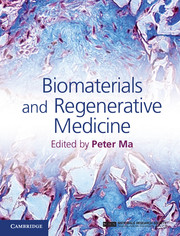Book contents
- Frontmatter
- Contents
- List of contributors
- Preface
- Part I Introduction to stem cells and regenerative medicine
- Part II Porous scaffolds for regenerative medicine
- Part III Hydrogel scaffolds for regenerative medicine
- 14 Polysaccharide hydrogels for regenerative medicine applications
- 15 Functionalized poly(ethylene glycol) hydrogels for controlling stem cell fate
- 16 Fumarate-based hydrogels in regenerative medicine applications
- 17 Hydrogel scaffolds for regenerative medicine
- 18 Microfabricated gels for tissue engineering
- 19 Organ printing
- Part IV Biological factor delivery
- Part V Animal models and clinical applications
- Index
- References
14 - Polysaccharide hydrogels for regenerative medicine applications
from Part III - Hydrogel scaffolds for regenerative medicine
Published online by Cambridge University Press: 05 February 2015
- Frontmatter
- Contents
- List of contributors
- Preface
- Part I Introduction to stem cells and regenerative medicine
- Part II Porous scaffolds for regenerative medicine
- Part III Hydrogel scaffolds for regenerative medicine
- 14 Polysaccharide hydrogels for regenerative medicine applications
- 15 Functionalized poly(ethylene glycol) hydrogels for controlling stem cell fate
- 16 Fumarate-based hydrogels in regenerative medicine applications
- 17 Hydrogel scaffolds for regenerative medicine
- 18 Microfabricated gels for tissue engineering
- 19 Organ printing
- Part IV Biological factor delivery
- Part V Animal models and clinical applications
- Index
- References
Summary
Introduction
This chapter begins by reviewing the structure and origin of polysaccharides commonly used in hydrogels and then moves on to a brief discussion of the role of structural polysaccharides throughout tissues in the body. Common chemical modification techniques are discussed, followed by approaches used to crosslink polysaccharides into insoluble hydrogels. The authors will also describe recent research approaches for polysaccharide hydrogel materials as scaffolds for tissue engineering, vehicles for drug delivery, and tissue adhesives. The goal of this chapter is to provide the reader with an overview of the exciting potential of polysaccharide-based hydrogels in medicine.
Structure and origin of common polysaccharides
Polysaccharides are large linear or branched carbohydrate molecules composed of repeating monomer units. They can perform structurally, as in the extracellular matrix of animals and cell walls of plants [1], or provide energy storage capacity in the instances of glycogen and starch [2]. Every organism on the planet has the ability to produce polysaccharides. Solubilities of polysaccharides in water vary depending on the chemical structure [3]. Monomer units often contain chemical groups that can be functionalized chemically in order to modify their material properties. Important structural polysaccharides in the human body are known as glycosaminoglycans (GAGs), which are anionic, linear polysaccharides composed of repeating disaccharide units. The repeat unit is comprised of a hexosamine and either a hexose or hexuronic acid.
- Type
- Chapter
- Information
- Biomaterials and Regenerative Medicine , pp. 247 - 262Publisher: Cambridge University PressPrint publication year: 2014



